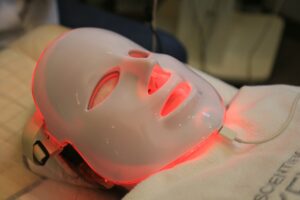Fact Or Fiction: LED Light Therapy
Posted by Emma Reid on 2nd Feb 2023

Have you seen those LED face masks on Instagram? We’re taking a look at what all the fuss is about.
Like something out of slightly dodgy 90s cartoon, these odd-looking face masks are everywhere on social media at the moment. They get prescribed as a cure for all manner of skin complaints. But do they work?
The Facts
LED light therapy has been used by professional dermatologists for a couple of years now, it’s just gotten more visible with the creation of face masks that can be used at home.
These devices are designed to be used for a couple of minutes a day, shining different colours of LED light onto your skin to create a non-invasive treatment that makes your skin look and feel better.
Red light, for instance, is good increasing collagen and elastin production, while blue kills acne causing bacteria. Yellow light can help with wound healing.
It sounds a little too good to be true. But the science suggests that when you expose yourself to LED light, your cells behave in a similar way as when they’re exposed to vitamin C or retinol.
Anecdotal evidence from people who try out the masks say they definitely have a noticeable impact on their skin quality. In short, the science definitely backs this one up!
Like a lot of things in the skincare world, your experience may vary. It’s well worth trying out a professional treatment before you commit to an expensive at home mask.
As a rule, you should follow the advice of a qualified dermatologist and see if it’s something they’d recommend for you, as you have to follow a specific plan with goals in mind to get the most out of it.
Some Safety Bits
LED light therapy doesn’t use ultraviolet rays, so they’re safe for regular use. They also don’t burn your skin compared to alternative skin treatments (like chemical peels or dermabrasion).
However, medical professionals do advise that you should avoid LED light therapy if you take Accutane for acne, or are experiencing a rash, as this could cause irritation. Other side effects are rare but can still occur. These include increased inflammation, redness and rashes.
What About Ordinary Lights?
Sitting around in ambient LED light isn’t really a substitute for specialised LED light therapy- even if you’re rubbing your face on your bulbs (which we wouldn’t recommend anyway). It just won’t be intense enough.
However, there is some evidence to suggest that people feel more energised when working in spaces that use LED lights, so it can definitely help you feel better!
We may not be in the LED face mask business, but we can still answer other questions you may have about LED lighting! Please feel free to give us a call on 0116 321 4120 or send us an email to cs@wled.co.uk, and our team will be more than happy help you out.
Don’t forget that you can keep up to date with all our latest news and products by taking a look at our Facebook and Instagram pages, and a follow on our Twitter feed! You can also subscribe to our YouTube channel.





